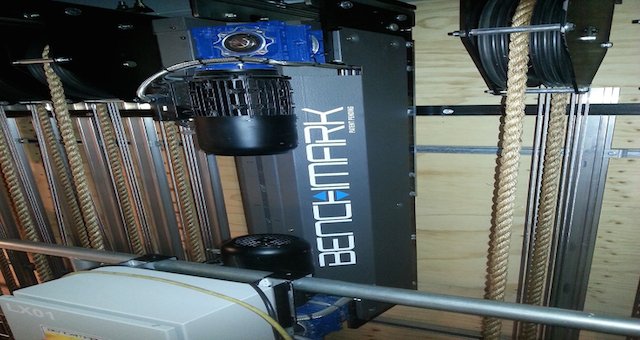News
1 Jul 2015
A Benchmark In Safety – Guilford Young College’s Hybrid Flying System Educates And Protects

Subscribe to CX E-News
Hobart’s Guilford Young College have positioned themselves as an educational gateway to the arts with the completion of a purpose-built performing arts centre at their Glenorchy Campus. The culmination of years of discussions, consultations with partner organisations and fundraising have led to the establishment of a new, professional standard venue whose facilities are matched in Hobart only by the much-beloved Theatre Royal.
Alongside students training in music, dance and drama, Guilford Young teach the theatre technicians of tomorrow all the skills they’ll need to work in professional venues; lighting, sound and mechanical skills. Fitted with a fly tower, students learn how to fly sets and equipment using a mixture of manually operated counterweights and motor-driven systems. With lighting, sound and scenic elements flown above the heads of those on stage, safety is paramount. In choosing flying equipment, the team at Guilford Young had to ensure that it enabled them to teach to industry standard while protecting the life and limb of everyone using the facility.
“We originally specified the theatre to have five lighting bars with counterweights,” said Mathew Andrewartha, Performing Arts Technician at Guilford Young College. “But we then decided to put four of them on electric hoists. There are OH&S advantages of a hoist over a counterweight system, in addition to their ease of use. But there’s also the variety that having both counterweights and electric hoists offer us. We need to teach on industry standard equipment, and while counterweights are still prevalent in professional venues, there’s a distinct move towards electric hoists.”

With the safety of their students foremost in mind, Guilford Young chose Jands new Benchmark hoists. Built with redundant motors, gearboxes and brakes, the Benchmark hoist was designed from the ground-up to provide the best possible protection in what is often a high-risk environment. “Compared to other hoists on the market, the Benchmark is smaller, lighter and much easier to use and service, without compromising on any safety aspects,” Matthew related. “The fact they’re a fully enclosed unit is also important, because there’s no issue with pinch points. The Benchmark is the only hoist we know of that’s designed for entertainment to be certified to this level of safety.”
“We went through four designs before we arrived at this one,” explained Chris Clegg, the designer at Jands responsible for the Benchmark hoist. “We wanted the machine to be designed to the Australian Standard AS1418 (Cranes Hoists and Winches) and in particular clause 7.12.8.5; Special Lifting Applications. We have the view that when you lift equipment on a hoist in a venue, it’s a high-risk situation. In a theatre, people are underneath these machines. If something fails or falls, it can cause injury or death. In most other hoists, if some portion was to fail and the load was to start travelling, it would need to reach a speed one and a half times the normal lowering speed before the emergency brake activates. But if you don’t want to lose control of the load before the brake activates, you need a redundant drive system.”
This is why the Benchmark is fitted with patent-pending monitoring and a totally redundant drive train. “What we’ve done is protect the load on both sides with a brake and a gearbox,” Chris described. “Both motors are being monitored, and if they get out of sync, a brake is applied. Each brake is rated at 1.6 times the entire capacity of the machine itself. If any component fails, the equipment is still always attached to a full capacity brake. When we first designed the Benchmark, we wanted to stretch the level of safety in what we make. We’ve done this, and had an independent engineering company certify the Benchmark to this standard.”
The Benchmark is a scaled-down, high-performance machine with a high-risk certification, designed for the smaller theatre market. Available in four models, the VS-1, VS-2, VS-3 and VS-4, the most powerful unit can lift up to 650kg at 14 metres a minute, while the fastest can fly a load at 1.2 metres a second. “People need to understand the risk of hoisting equipment in a theatre,” cautioned Chris Clegg. “We can’t neglect or negate the risk that there’s equipment hanging over people’s heads. But we can build equipment to a high enough safety level that means the risk is as low as possible.”
The four units at Guilford young are controlled via a Jands SAX-P1 single axis controller, giving the students the ability to record and playback six preset positions. Matthew Andrewartha also appreciates their zero fleet design; “The Benchmark doesn’t have a fleet angle for the wires that feed in to the hoist, so there’s no ‘clear area’ you have to maintain for operation,” he confirmed. “They can be mounted directly to the head steels the same way the head blocks for the counterweights are and there’s no additional ‘danger zone’ where the lines come through.”
After working through the design and construct process with Jands, Bobby Court, Principal of Guilford Young College, is more than happy with the result. “We simply cannot say enough positive things about Jands,” she beamed. “The building construct was complex and engaging an outside contractor to install the internal workings of our fly-tower represented a significant risk for our management of the build. The team that worked on our project has been fantastic from end to end. From design to install, they were a dream to work with. On install, they were on site for six weeks and worked perfectly with every other trade on site. We are delighted with the final product and look forward to sharing its design and functionality with others.”

Subscribe
Published monthly since 1991, our famous AV industry magazine is free for download or pay for print. Subscribers also receive CX News, our free weekly email with the latest industry news and jobs.






